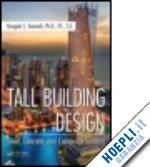Loads on Building Structures Preview Dead Loads Occupancy Loads on Buildings Snow Loads on Buildings Dead Loads Live Loads Construction Loads Lateral Soil Load Snow, Rain, and Ice Loads Thermal and Settlement Loads Self-Straining Forces Dynamic Loads Abnormal Loads Classification of Buildings, Risk Categories, and Importance Factors Wind Loads Preview Description of Wind Forces Types of Wind Storms Wind/Building Interactions Behavior of Tall Buildings Subjected to Wind Scope, Effectiveness, and Limitations of Building Codes ASCE 7-10 Wind Load Provisions, Overview Earthquake Effects on Buildings Preview Inertial Forces and Acceleration Duration, Velocity, and Displacement Acceleration Amplification due to Soft Soil Natural Periods Building Resonance Site Response Spectrum Damping Ductility Earthquakes and Other Geologic Hazards Earthquake Measurements Determination of Local Earthquake Hazards Nonstructural Components Seismic Analysis Procedures System Selection Seismic Issues due to Configuration Irregularities Structural Dynamic Response Spectrum Method Seismic Design Considerations Lessons from Past Earthquakes Seismic Design Wrap-Up Dynamic Analysis, Theory Anatomy of Computer Response Spectrum Analyses Wind Design with Particular Reference to ASCE 7-10 Preview Directional Procedure (Analytical Procedure): Overview Significant Changes in the ASCE - Wind Load Provisions ASCE 7-10 Wind Provisions Update: Summary Overview of ASCE 7-10, Chapter 26 Discussion of ASCE 7-10, Chapter 26 Discussion of ASCE 7-10, Chapter 27 Discussion of ASCE 7-10, Chapter 28 (Envelope Procedure for MWFRS of Low-Rise Buildings) Discussion of ASCE 7-10, Chapter 29 (Wind Loads on Buildings Appurtenances and Other Structures) Discussion of ASCE 7-10, Chapter 30 (Wind Loads on Components and Cladding) Wind Tunnel Procedure Human Response to Wind-Induced Building Motions Building Periods Pedestrian Wind Studies Seismic Design with Particular Reference to ASCE 7-10 Seismic Provisions Preview ASCE 7-10, Chapter 11, Seismic Design Criteria ASCE 7-10, Chapter 12, Seismic Design Requirements for Building Structures Performance-Based Design Preview Definitions of Performance-Based Design Prescriptive Approach to Codes Performance-Based Approach Improving Performance to Reduce Seismic Risk Design and Performance Issues Relating to Commercial Office Buildings Current Specifications for Performance-Based Seismic Design Closing Comments Preliminary Calculations to Ensure Validity of Computer Analysis Preview Characterizing Structural Behavior Advantages and Disadvantages of Indeterminate Structures Preliminary Design: Concrete Estimation of Preliminary Wind Loads, ASCE 7-10 Preliminary Seismic Base Shear, V, as a Percent of Building’s Seismic Weight, W Differential Shortening of Steel Columns Guidance for Preparing Conceptual Estimates Concept of Premium for Height Seismic Evaluation and Rehabilitation of Existing Buildings Preview Code-Sponsored Design Alternate Design Philosophy Seismic Rehabilitation of Existing Buildings ASCE/SEI Standard 41-06 Common Deficiencies and Upgrade Methods: Concrete Building Concluding Remarks Seismic Strengthening Details Special Topics Preview Serviceability Considerations Damping Devices for Reducing Motion Perception Seismic Isolation Passive Energy Dissipation Blast-Resistant Design Failures and Distresses Buckling of Building under Its Own Weight Foundations Evolution of High-Rise Architecture Posttension Strengthening of Existing Structures Reinforced Concrete Special Moment Frames Torsion Preview Concept of Warping Behavior Sectorial Coordinate ?' Shear Center Evaluation of Produce Integrals Principal Sectorial Coordinate ?s Diagram Calculation of Sectorial Properties: Worked Example General Theory of Warping Torsion Torsion Analysis of Shear Wall Building: Worked Example Warping Torsion Constants for Open Sections Stiffness Method Using Warping-Column Model Seismic Design: A Pictorial Review Preview Figures and Tables Explaining the Fundamentals of Seismic Design Steel Buildings: Bolted and Welded Connections, Gravity, and Lateral Load-Resisting Systems and Details Preview General Considerations for Welds Methods of Welding Inspection Bearing versus Slip-Critical Connections Field Tolerances Brittle Fracture ASTM Specifications for Structural Shapes, Plates and Bars, and Fasteners Thermal Effects on Structural Steel Bolted Connections Bolts Subjected to Shear and Tension Tables and Figures Describing Gravity and Lateral Load-Resisting Systems Typical Details Reinforced Concrete Buildings: Structural System and Details Preview Characteristics of Reinforced Concrete Formwork Considerations Floor Systems Prestressed Concrete Foundations Lateral Load Resisting System Structural Systems Composite Buildings: Structural System and Details Preview Composite Metal Deck Specifications for Metal Deck: Overview ANSI/SDI (C1.0 Standard for Composite Floor Deck): A Brief Review Composite Beams Composite Joists and Trusses Other Types of Composite Floor Construction Continuous Composite Beams Nonprismatic Composite Beams and Girders Moment-Connected Composite Haunch Girders Composite Columns Design Tables and Details Bibliography Index











